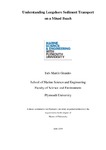Understanding Longshore Sediment Transport on a Mixed Beach
| dc.contributor.supervisor | Simmonds, Dave J. | |
| dc.contributor.author | Martín Grandes, Inés | |
| dc.contributor.other | School of Biological and Marine Sciences | en_US |
| dc.date.accessioned | 2015-06-12T08:33:21Z | |
| dc.date.available | 2015-06-12T08:33:21Z | |
| dc.date.issued | 2015 | |
| dc.date.issued | 2015 | |
| dc.identifier | 10088215 | en_US |
| dc.identifier.uri | http://hdl.handle.net/10026.1/3364 | |
| dc.description.abstract |
The aim of this study is to acquire a better understanding of the short to medium timescale (diurnal to monthly) morphodynamic behaviour of mixed, sand and shingle, beaches. In particular, this project intends to provide a new approach to estimate longshore sediment transport (LST) rates on a mixed beach. In order to do that, the mixed beach at Milford-on-Sea, Hampshire UK, was subject of a novel field experiment consisting on an impoundment technique, where beach profiles were measured daily over two months using RTK-GPS. Meanwhile, the nearshore hydrodynamic conditions were measured collecting wave and tidal data. Then, the short to medium term morphological variability of the beach shoreline was investigated related to the hydrodynamic regime. Understanding the longshore sediment transport processes is important for applying the adequate coastal management policy. At the same time it is imperative to develop methodologies that can be applied widely to other coastal sites with similar characteristics. Among the different methods for measuring LST rates, the impoundment technique was considered as an appropriate approach field wise because its efficiency for trapping sediments has been demonstrated, mainly within the swash zone, which significantly contributes to the longshore sediment transport. The results from the analysis of the beach profiles based on the Energy Flux method showed that it is a good approximation to relate beach morphology changes to the hydrodynamic conditions. Five different longshore sediment transport coefficients k were obtained using the CERC Equation (1984) considering different approaches for beach volume computations taking into account the effect of the tides. Only one sediment transport coefficient was of a similar order of magnitude than other values found in the literature for coarse sediments. Results of this study shows the importance of the seaward limit of the beach profile when computing LST rates to ensure that the range of action of the sediment transport processes is considered. A one- line shoreline model was validated using the Milford-on-Sea field data collected in order to assess the capability of the model to predict shoreline changes for a mixed beach. The sensitivity analysis on the calculated sediment transport coefficients shows that higher coefficients over-predict shoreline changes as compared to lower coefficients. The comparison between modelled and measured shorelines shows consistent patterns but a significant shift in the offshore direction. | en_US |
| dc.description.sponsorship | Faculty of Technology and Engineering fees-only scholarship | en_US |
| dc.language.iso | en | en_US |
| dc.publisher | Plymouth University | en_US |
| dc.subject | Mixed beach | |
| dc.subject | CERC Equation | |
| dc.subject | Beach profile | |
| dc.subject | Transport rate coefficient | |
| dc.subject | Longshore sediment transport | en_US |
| dc.title | Understanding Longshore Sediment Transport on a Mixed Beach | en_US |
| dc.type | Masters | en_US |
| plymouth.version | Full version | en_US |
Files in this item
This item appears in the following Collection(s)
-
01 Research Theses Main Collection
Research Theses Main


